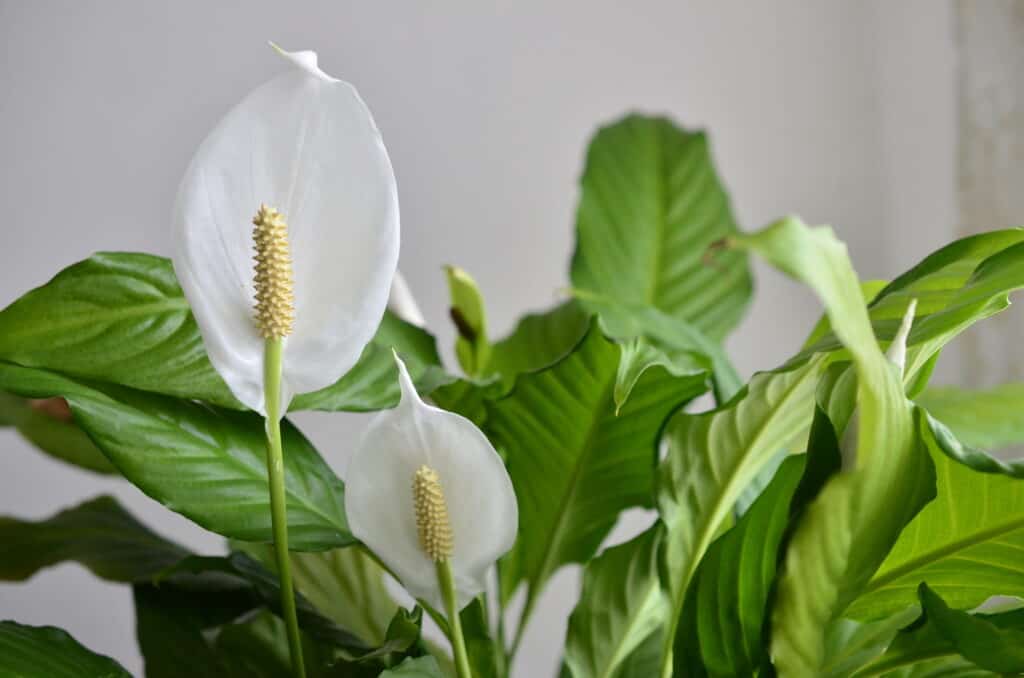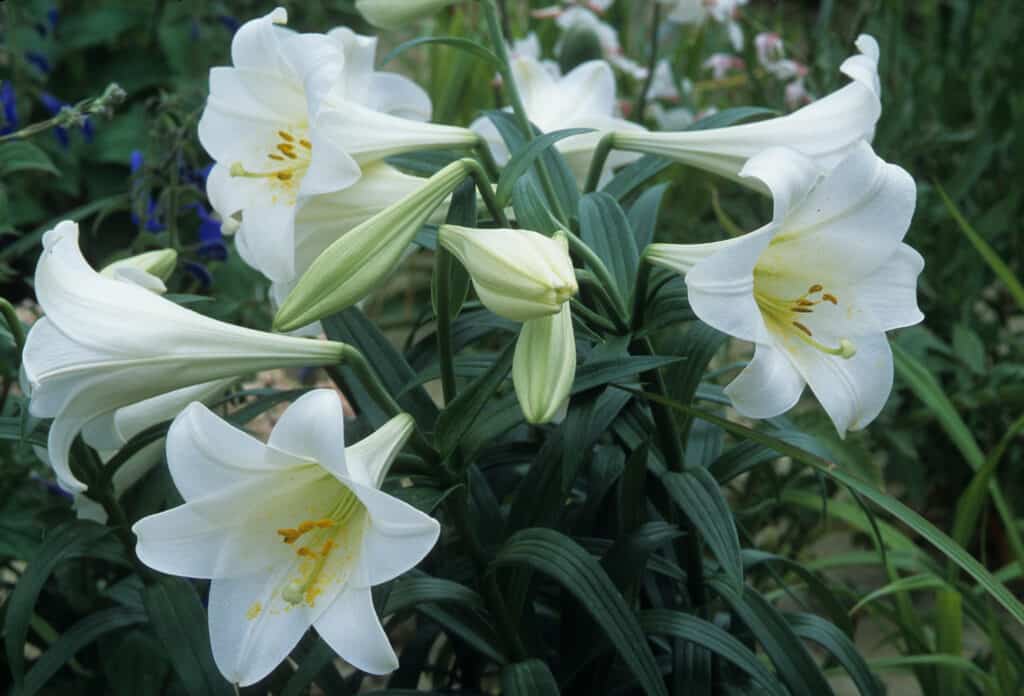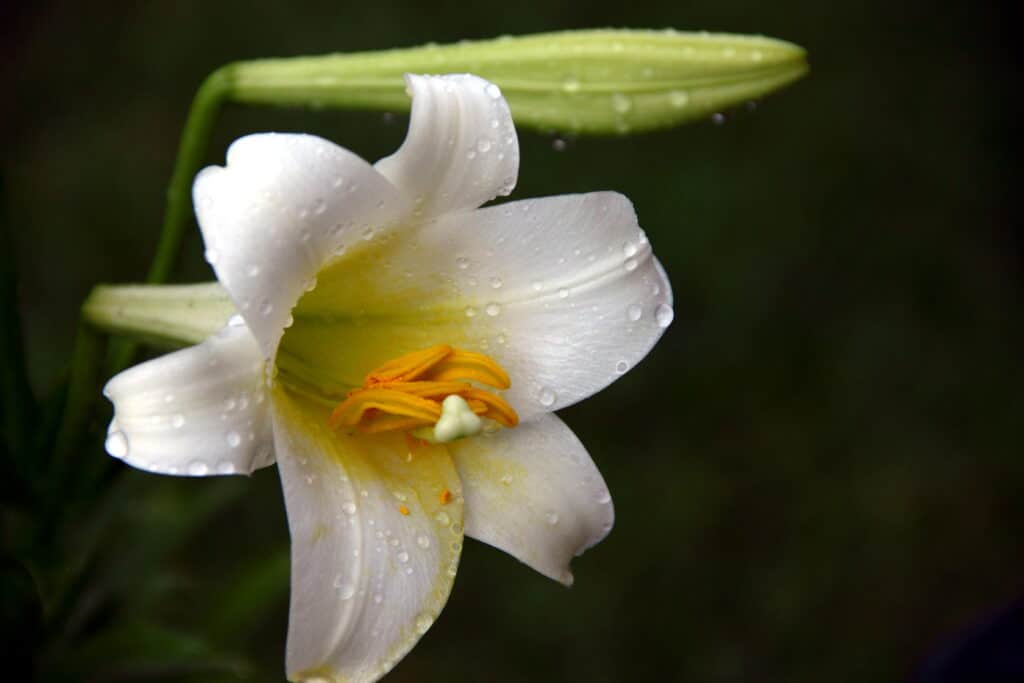Easter lilies and peace lilies are two classic, favorite flowers often grown as houseplants. In general, lilies are beloved and hold great symbolic meaning in modern Western cultures. Their shining, bright white leaves sometimes represent beauty, fertility, love, innocence, or purity. However, their beautiful flowers and similar names often lead different species and even genera to be confused with each other. How can you tell them apart?
Because both Easter lilies and peace lilies have the word “lily” in their common names, they are often confused with each other and mistakenly thought to be members of the same family. However, while the Easter lily is a member of Liliaceae, the lily family, the peace lily is not! In fact, “peace lily” refers to the Spathiphyllum genus, which is part of the Araceae, or arum, family.
This article will explore some of the other differences between the two plants. First, here are some characteristics that Easter lilies and peace lilies have in common:
- Both are relatively easy-to-grow plants that can thrive indoors or outdoors in the right conditions
- Both produce beautiful, white flowers
- Both are symbols of love, hope, purity, and other positive virtues in Western cultures
However, there are also a number of ways in which Easter lilies and peace lilies are different. This article will compare and contrast the two plants, so that by the end of the article, you should understand the history and origins, appearance, and growing conditions for both. Let’s dive in and learn more about Easter lilies and peace lilies now!
Comparing Easter Lilies and Peace Lilies
| Characteristic | Easter Lily | Peace Lily |
|---|---|---|
| Scientific Name | Lilium longiflorum (species) | Spathiphyllum (genus) |
| Family | Liliaceae | Araceae |
| Common Name | Easter lily | Peace lily |
| Origin | Japan, Taiwan | Colombia, Venezuela |
| Description of Plant | Lilium longiflorum is the scientific name for the species known commonly as an Easter lily. Easter lilies are perennials which produce large, trumpet-shaped white flowers. Easter lilies grow to be up to 36 inches tall, with some variation depending on the specific cultivar. | Spathiphyllum is a genus of dozens of different plants known as peace lilies. Peace lilies are evergreen plants native to tropical areas, which produce white or off-white flowers that bloom in the early summer and will continue to bloom throughout the year. Most indoor peace lily varieties will grow to be up to 16 inches tall, while outdoor varieties may grow to be 6 feet tall. |
| Growing Conditions | Easter lilies thrive in bright, indirect sunlight and soil with good drainage. | Peace lilies thrive in dappled sunlight and warm, moist or humid conditions in soil with good drainage. |
| USDA Hardiness Zone(s) | 5-11 | 10-11 |
Descriptions of Easter Lily and Peace Lily
The Easter lily, Lilium longiflorum, is an actual lily in the family Liliaceae. Liliaceae includes multiple genera and more than 600 different species of flowering plants called lilies. Easter lilies are perennials which produce large, trumpet-shaped white flowers. Easter lilies grow to be up to 36 inches tall, with some variation depending on the specific cultivar. Different varieties can produce many different flowers, which range in size but can be 3 to 7 inches long typically.
The Spathiphyllum genus includes about 40 different species of plants commonly known as peace lilies. Peace lilies are not truly members of the lily family, but belong in the Araceae family, which includes other species such as callas and elephant ears. They are easy to grow and popular plants for that reason, and these herbaceous perennials are often grown as houseplants. The sail-like flowers grow to be 4 to 12 inches long and bloom above the leaves, and look to be flat, with a prominent spadix.

Peace lilies have sail-like flowers that grow 4 to 12 inches long and bloom above the leaves with a flat appearance.
©armifello/Shutterstock.com
Easter Lily vs. Peace Lily: History
Lilium longiflorum, commonly known as an Easter lily, gained its name for being a flower traditionally grown during the springtime around Easter. However, early springtime is not their natural flowering season.
Lilium longiflorum is native to Japan, specifically three small southern islands known as the Ryukyu Islands. For centuries, the plant was cultivated in China and Japan. After being sent from Asia to England in 1819 by a man named Carl Peter Thunberg, growing the so-called Easter lily became popular in Europe, with bulbs exported from Asia to Europe and North America. However, since the mid-20th century, the United States has risen in prominence as one of the main cultivators and exporters of Easter lily plants. Today, they are primarily cultivated in the western U.S., especially in California and Oregon.
Plants in the Spathiphyllum genus grow natively in Colombia, Venezuela, and other South American countries. These species grow natively in a tropical rainforest environment, but was introduced to Europe and North America in the 1800s, growing in popularity to become one of the most popular houseplants.
Easter Lily vs. Peace Lily: Appearance
Lilium longiflorum grows up to 3 feet tall, though many plants never reach that full height. The Easter lily stem grows from a bulb planted in the ground, with the stem covered in leaves that reach up to 6 inches long. The lily flowers grow outward and perpendicular to the stems and are trumpet shaped. The most popular varieties are typically white or white-yellow, with yellow stamens, though the flowers of other cultivars can range in color. The tubular flowers reach between 3 and 7 inches long.
Plants in the Spathiphyllum genus, which are known as peace lilies, grow to be between a foot and 4 feet tall. However, there are a few cultivars that can be taller. They produce slightly fragrant white flowers, dark green, glossy leaves. With dozens of different species in the peace lily genus, there are many different varieties that have been developed for their unique appearance – growing variegated leaves, reaching varying size, and producing blooms that emit sweet, mild fragrances.

Easter Lily (
Lilium longiflorum) flowers grow outward and perpendicular to the stems and are trumpet shaped.
©COULANGES/Shutterstock.com
Easter Lily vs. Peace Lily: Growing Conditions
Easter Lily Cultivation
Today, most of the Easter lily cultivation in the United States is of one variety, the ‘Nellie White.’ Easter lily bulbs are grown for 3 or 4 years, replanted each year in fields until they reach size and maturity to be shipped throughout North America. From there, they are grown to flower in early spring, in the weeks around Easter Sunday. If you would like to grow your own Easter lily, you will likely find it easiest to grow them from a bulb planted 4 to 6 inches deep in the ground, about a foot apart from each other. If growing an Easter lily indoors in a container, place the plant near a window where they can receive bright, indirect sunlight. Ensure that the plant has adequate drainage, protection from hot afternoon sun, and evenly moist soil.
Both of these plants have similar needs when they are grown indoors. However, Easter lilies fare better in colder climates.
Peace Lily Cultivation
Peace lilies grow best in warm, humid conditions with dappled sunlight, like what they would receive naturally growing in tropical environments on the forest floor. When growing indoors, keep your peace lily in temperatures above 60 degrees Fahrenheit, ideally in rooms with temperatures above 70 degrees Fahrenheit. They also grow best in conditions of high humidity, so you can recreate their original tropical forest growing environment by using a humidifier, misting their leaves, or using watered rock beds to increase your peace lily’s humidity.
Peace lilies are also particularly sensitive to drought and will show their dehydration through crispy brown leaf tips when their soil becomes overly dry. Avoid this by keeping their soil moist but not overly saturated. You will also want to grow your peace lily near a window or source of bright, indirect light. Don’t put them in an area where they will receive direct sunlight throughout the day. Instead, favor east- or north-facing windows where they will get bright, indirect sunlight.
Easter Lily vs. Peace Lily: Toxicity
If you choose to grow either an Easter lily or peace lily at home, it is very important to know that both plants are considered to be toxic and should be kept away from pets and small children. Most lilies are considered to be mildly toxic, and Easter lilies are no exception. Additionally, peace lilies contain a toxic chemical that can harm those who ingest it.
Easter lilies are considered to be highly toxic for cats in particular. For cats, the flowers are especially toxic. There have been deaths of cats reported after the animal ate only two leaves. Dogs and bunnies were not affected even after being fed larger doses of Easter lily plants as part of an experiment.
In comparison, the leaves, flowers, pollen, and stems of lilies contain a substance called calcium oxalate. Calcium oxalate is toxic when ingested. It causes internal irritation and can cause a tingling or burning sensation, swelling of the lips and mouth, and trouble breathing or swallowing. However, it is not as dramatically toxic as the Easter lily to cats.
Both Easter lilies and peace lilies are somewhat poisonous if eaten, but the symptoms are usually mild in humans. However, to be safe, keep them both away from pets, such as dogs or cats, or small children who might eat the plant.
Easter Lily vs. Peace Lily: Varieties
Easter lilies come in many different varieties. The ‘Nellie White’ cultivar is popular at Easter time. ‘Nellie White’ is the most commonly cultivated variety in North America, but other varieties range in the color of their flowers and size of the plant.
- ‘Deliana’: A variety that produces yellow flowers.
- ‘Trimphator’: A variety with white flowers that have pink centers.
- ‘White Elegance’: A variety that produces numerous bright white flowers that are smaller in size.
- ‘Elegant Lady’: A variety that produces pink flowers that bloom with a sweet scent.
- ‘White Heaven’: A variety that grows to be 2 to 3 feet tall and produces 7-inch flowers.
Peace lilies come in many different varieties, which range from very common to exceedingly rare. Look out for particular varieties that have been bred for their size, unique leaves, or other desirable qualities.
- ‘Jet Diamond’: A variety that has variegated leaves striped in silver-white.
- ‘Petite’: A small variety that only grows to be between 8 and 10 inches tall.
- ‘Sensation’: The largest variety, and one which can grow to be up to 6 feet tall.
- ‘Domino’: A medium-sized variety that grows variegated leaves with white spots on its dark-green foliage.
- ‘Mojo lime’: A medium-sized variety that grows leaves that are lime green in color.

‘Nellie White’ is the most commonly cultivated Easter lily variety in North America.
© – License
In Summary
This article compares the Easter lily with the peace lily, as two beautiful flowering plants. As we covered in this article, only one of these two are actually members of the lily family. The Easter Lily is a true lily. It’s a member of the Lilium genus. In contrast, peace lily contains many different species in the genus Spathiphyllum. Knowing these two apart by their flowers and origins can help you appreciate the unique value each brings!
Up Next
- Daylily vs Lily: What Are Their Differences?
- Asiatic Lily vs. Daylily: Key Differences to Know
- Are Lilies Poisonous To Dogs Or Cats?
The photo featured at the top of this post is © COULANGES/Shutterstock.com
Sources
- Wisconsin Horticulture Division of Extension, Available here: https://hort.extension.wisc.edu/articles/easter-lily-lilium-longiflorum/
- North Carolina Extension, Available here: https://plants.ces.ncsu.edu/plants/spathiphyllum/
- Farmers Almanac, Available here: https://www.almanac.com/plant/peace-lilies
- North Carolina Extension, Available here: https://plants.ces.ncsu.edu/plants/lilium-wallichianum/
- Pet Poison Hotline, Available here: https://www.petpoisonhelpline.com/pet-safety-tips/are-lilies-poisonous-to-cats/
- ASPCA, Available here: https://www.aspca.org/pet-care/animal-poison-control/toxic-and-non-toxic-plants/easter-lily
- ASPCA, Available here: https://www.aspca.org/news/top-10-toxic-plants-pets-what-look-out#:~:text=Peace%20lilies%20may%20add%20a,upset%2C%20drooling%20and%20mouth%20pain.
Thank you for reading! Have some feedback for us? Contact the AZ Animals editorial team.






